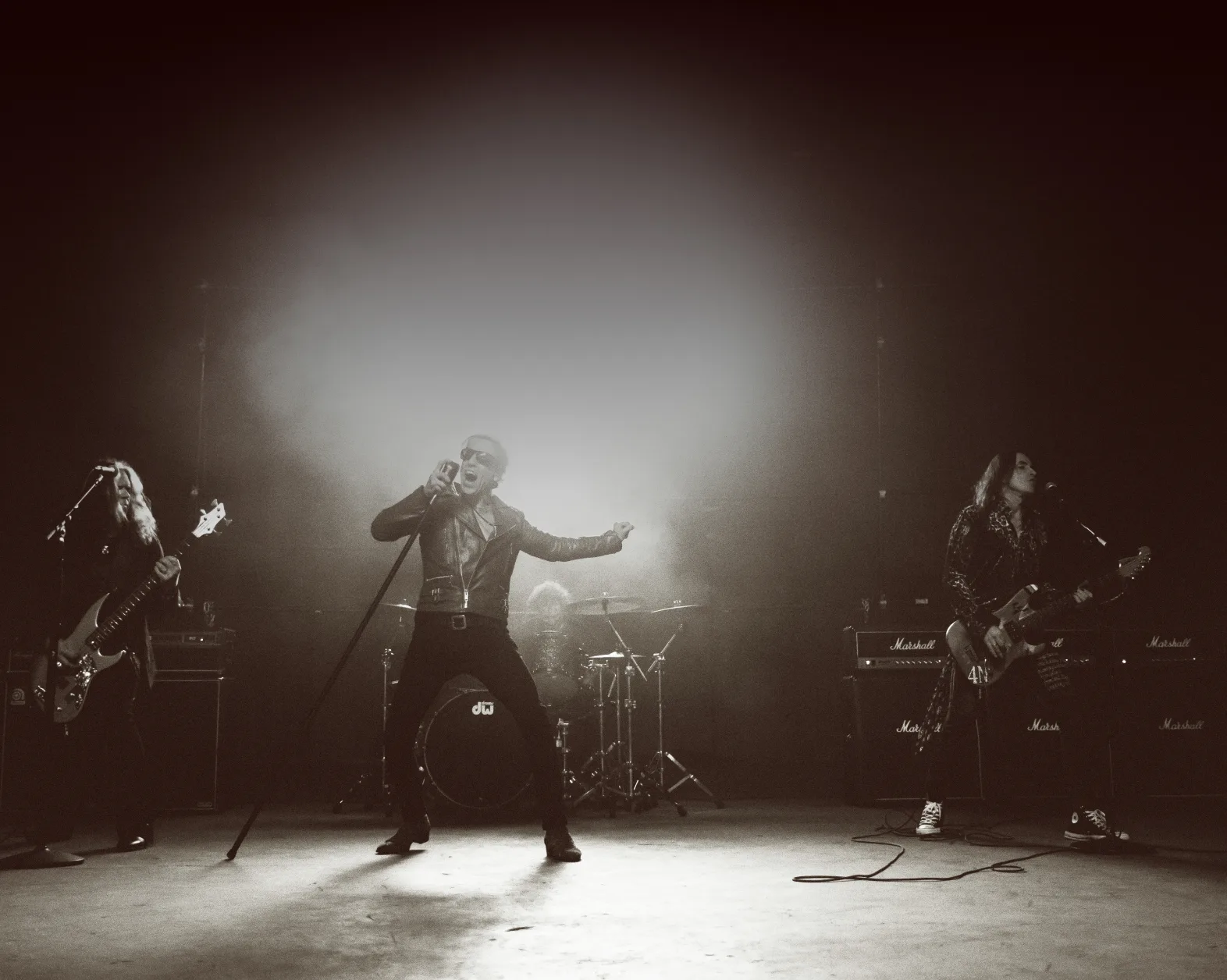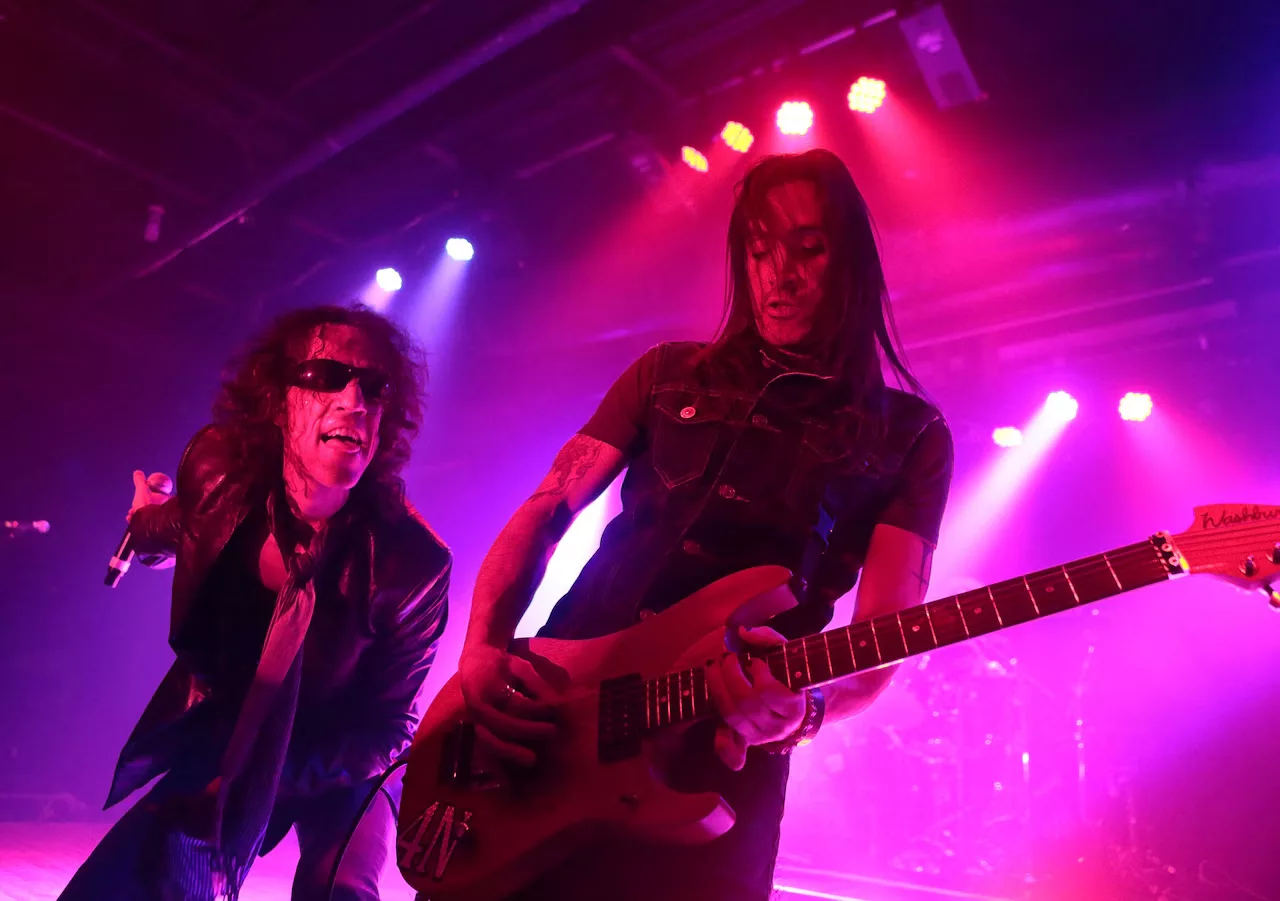via Al.com
Three decades after their breakthrough, Extreme are now in the rare position of a veteran act whose fans are coming to shows psyched to hear new songs.
Checking in mid-tour from an Atlanta hotel room, guitarist Nuno Bettencourt says, “It’s been insane. We’re doing five or six songs off the new album right now in the set, which is unheard of. Mostly, when a band does stuff off a new album, everybody runs for the concessions and toilets. But it’s actually been the highlights of the evening.
“And in the dressing room we talk about this: It reminds us of when ‘Porno’ was breaking back in the day. It’s obviously not in the realm of a hit like ‘More Than Words’ of course, but it’s in the realm of the excitement around it and the freshness.”
In 1990, Extreme’s sophomore album, “Extreme II: Pornograffitti,” took the Boston-founded quartet to the masses. The LP went double-platinum playing to the elastic musicality of frontman Gary Cherone, guitarist Nuno Bettencourt, bassist Gary Badger and drummer Paul Geary. Tracks ranged from the slippery hard-rock of “Get The Funk Out” to chart-topping ballad “More Than Words” to acoustic hoedown “Hole Hearted.”
Last year, Extreme released “Six.” Their sixth studio effort, and first in 15 years, was one of the best rock releases of 2023. Cherone, Bettencourt and Badger sounded like they’d been teleported back to their prime, on searing rockers like “Banshee” and tuneful strummers like “Other Side Of The Rainbow.” Extreme’s latter day drummer Kevin Figueiredo nailed it too. (Classic-era drummer Geary left Extreme in the mid ‘90s to become a successful manager of artists including Godsmack.)
In particular, “Rise,” the opening track on “Six,” excited rock fans like few recent tracks have. Bettencourt’s bolero-metal solo on that song is breathtaking and for guitarists, from bedroom musicians to famous string-benders, inspiring. Surprisingly, as accomplished as the “Rise” guitar solo is, it was mostly instinctual.
Bettencourt says, “I’m of the mind that if something is feeling good then it’s meant to happen. When I record if I spend too much time, hours or days on anything, I’m forcing it at this point.
“Cutting a guitar solo, I kind of black out. I’m in there [in the studio] by myself, and I feed off the band and the track and I just go. And if something magical happens, I’m like, oh that was cool. ‘Rise’ was pretty quick and pretty fast. And the day I was recording that solo, Eddie Van Halen turned up at my house. That didn’t hurt.”
A huge musical inspiration for Nuno, Eddie became a friend too. This day, when Van Halen visited Bettencourt’s Los Angeles-area home, he wanted to hear what Bettencourt was working on. Nuno wanted to finish the track first, which Eddie understood. Unfortunately, it was the last time Bettencourt would ever see Van Halen, who died in 2020 after a long fight with cancer.
Recently, Bettencourt, who has his own Washburn N4 signature guitars, had a replica of Van Halen’s black-with-yellow-stripes “Bumblebee” guitar made. Bettencourt’s Bumblebee will appear in a music video Extreme recently shot for “Beautiful Girls,” the world-music-spiced “Six” closing track that shares a title with a ‘79 classic Van Halen cut.
“That was always my favorite looking guitar of his,” Bettencourt says of Eddie’s original Bumblebee. “I used to be obsessed with staring at the ‘Van Halen II’ [album] artwork. It’s just so iconic to me, more than any other of his guitars since.
“And I’d never owned one, so I reached out to one of the only guys that Edward trusted to make his replicas, and he made one for me in the N4 body. It’s just a little tribute.”
By the time of “Pornograffitti,” the band was stirring acoustic guitars into their sound. Bettencourt’s strong harmony vocals became more prominent, too.
“We never did acoustic music for the sake of doing acoustic music,” Bettencourt recalls. “Matter of fact, it was quite the opposite of what we should’ve been doing in ‘89, ‘90 or ‘91, because everything was about these massively produced power-ballads.
“We actually had a big problem with ‘More Than Words’ It went to number-one it just about every country in the world, but nobody wanted to put it out because they were like, ‘What are we gonna do with this right now?” Sitting down and doing harmonies like the Everly Brothers or The Beatles, it just wasn’t happening at all, in no format of radio.”
Everyone across the board, including Extreme’s management and label, Bettencourt says, told the band “More Than Words” wasn’t a single. Let alone a hit. It just wouldn’t work.
“I had to fight tooth-and-nail even to get them to test it in a couple of markets,” Nuno recalls. “But I think we’ve always been that band that’s outside the box, whether we like it or not. Rock ‘n’ roll or metal at the time, we didn’t fit because we had a bit of funk. And then there’s strange songs like ‘More Than Words’ or ‘Hole Hearted’ that were like, ‘What are you guys doing? We can’t figure out where to place you.’
“But I think that’s always worked to our benefit, to always do what we love. If everybody’s running the other way from the burning building, we kind of run into the burning building. It gave us our identity, which is what we learned from [bands like] Queen and Van Halen. Do what you want, and the best songs make the album. The songs dictated it.”
Besides their sonic range, Extreme could also burn it down with the best of them. For example, “Get The Funk Out” sounds like Aerosmith gorging on Red Hot Chili Peppers.
Bettencourt’s guitar solo – greasy, supersonic — on that track’s an all-timer. And one of many reasons this Portugal-born musician routinely makes notable “greatest guitarists” lists.
“That was a period,” Bettencourt says, “all the older albums especially, before we had Pro Tools and a laptop and all that, I would demo everything up on a four-track [tape recorder]. I would just write a groove on the drums and then I’d record that. Then I’d throw a bass lick down or whatever.
As a singer, songwriter and performer, Cherone’s quite the talent, too. In the late ’90s, he was brought in to front Van Halen after Van Halen parted ways with Sammy Hagar, who in the mid ‘80s replaced classic-era VH throat David Lee Roth.
The Cherone-sung “Van Halen III” album, released during a godforsaken time when teen-pop and rap-rock ruled Earth, wasn’t a rainmaker. But Cherone impressed on tour with his ability to crush both Hagar and Roth tunes on the mic. These days, when not busy with Extreme, Cherone is also frontman for Joe Perry Project, the Aerosmith guitarist’s side hustle.
Bettencourt says, “The reason me and Gary connected in the early, early days is because — it’s a corny thing – but you finish each other’s sentences. Musically. Melodically. We never really fought over music and things like that. We were both madly into things like Queen, Prince, Aerosmith, and The Who and [Led] Zeppelin.
“There was never a language barrier to writing and recording. And vocally, same thing. If I sang a part or if we did the harmonies, it was never like, ‘Oh, I’m the lead singer.’ Whatever worked naturally was what we were into.”
Extreme is currently touring with another blazing, not easily categorized, still-potent band from the late ‘80s: New York group Living Colour. Complete tour dates can be found at extreme-band.com. The trek hits Mars Music Hall in Huntsville, Alabama 7:30 p.m. tonight.
The pairing’s a throwback to the rock tours Bettencourt would see coming through Boston in his youth before Extreme took off: “Back then, the lineups were ridiculous. The most amazing two, three or four bands together. You look at posters from then now, and all of them became big bands and headliners at some point. We were spoiled.”
Around the time Extreme released “Pornograffitti,” an A&M Records rep asked if Bettencourt, then 21, would be interested in playing guitar on a version of label mate Janet Jackson’s song “Black Cat,” to be released as a single. (Note: He doesn’t appear in the accompanying music video.)
Bettencourt was already a big fan of Jackson’s. Sister of superstar singer Michael Jackson and a former “Good Times” child actor, she’d achieved her own pop stardom with excellent solo albums like “Control” and “Rhythm Nation 1814.”
Bettencourt jumped at the chance to be part of Jackson’s next single. He had to take a day off from Extreme to get it done.
“Two producers that I really admired,” Bettencourt says, Jimmy Jam and Terry Lewis, came down while we were recording, which blew my mind. As if that wasn’t enough, as I was recording it, Janet Jackson walks into the studio and sat like right behind me, in these tight quarters. For a young guitar player like myself, a young artist doing only his second album, it was pretty wild.”
After Eddie Van Halen played a dazzling solo on Michael Jackson’s 1983 number-one hit “Beat It,” it became cool for guitar hotshots to guest on a Jackson’s track. See Billy Idol shredder Steve Stevens’ riffage on MJ’s ‘88 chart-topper “Dirty Diana,” etc. As Bettencourt told me in our 2017 interview for an L.A. Weekly story, “[’Beat It’] changed the game.”
About 20 years after “Black Cat,” Bettencourt teamed with another high-profile female pop/R&B singer. He played lead guitar on Rihanna’s 2009, 2010, 2012 and 2013 tours. He also contributed to her “Rated R,” “Loud,” “Talk That Talk” and “Anti” albums.
On tour, Bettencourt was given carte blanche to guitar-ify RiRi hits.
“‘Umbrella” was always interesting,” he says, “because we got to do these big power-chords. Every song, she wanted it to be heavy, so that was kind of cool. Some of the early stuff I really love to do, like ‘Shut Up And Drive,’ we could rock-out and punk-rock out. And some of the reggae stuff, like ‘Man Down,’ was fun. There was a track called ‘Skin’ that she used to let me do these solos that were like seven or eight-minutes in the arenas. It was just incredible.”
Last year, Bettencourt reunited with Rihanna to be part of her blockbuster Super Bowl halftime performance.
Whenever he returns to Extreme after collaborating with Rihanna – or, say, recording with Aerosmith frontman Steven Tyler in Muscle Shoals — he brings back something new to imbue his music. “When it comes to creativity,” Bettencourt says, “you are what you eat. I’m always learning, man.”



